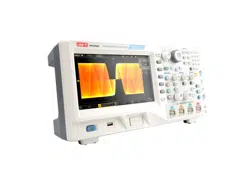Loading ...
Loading ...
Loading ...

31
Press the polarity key to select 2400bps, 4800bps, 9600bps, 19200bps,
38400bps, 57600bps, 115200bps, or user-defined. When selects the
user-defined option, adjust the baud rate by the Multipurpose knob or the
shuttle knob.
It is recommended to make reasonable settings based on your RS232
communication hardware and software. Limited by the basic model of the
transmission protocol, the RS232 protocol is usually used in short distance
(below 20m) and low speed (1Mbps) transmission occasions. Communication
beyond these ranges can be disturbed easily or become unreliable.
Bit Width:
Specifies the data bit width of the RS232 protocol signal that needs to be
decoded. Press PgDn bit width to select 5bits, 6bits, 7bits, or 8bits.
Bit Sequence:
Specify the data bits of the RS232 protocol signal that needs to be decoded
are high bit in front (MSB) or low bit in front (LSB).
Press PgDn bit sequence to select MSB or LSB.
(1) MSB: The high bit of the data transmits first.
(2) LSB: The low bit of the data transmits first.
Stop Bit:
Press PgDn stop bit to set the stop bit for each frame of data, you can
set it to 1 bit or 2 bits.
Parity:
Press PgDn parity to set the parity mode for data transmission, you can
choose none, even parity or odd parity.
Trigger Condition:
Press PgDn trigger condition to select start of frame, error frame, parity
error, and data.
(1) Start of Frame: The waveform trigger is at the start bit of the RS232
protocol (refer to figure). Stable waveforms can be observed by choosing
the start of frame trigger when single string signals or multiple same string
signals are sent. If the data being sent is changing, the waveform will
also change correspondingly.
(2) Error Frame: 0 occurs in the stop state or a data error occurs in the middle
of the data bits during the receiving process.
(3) Parity Error: Set the RS232 parity bit to 0 or 1 according to the parity
principles, the principles are as follows:
Odd Parity: If the total number of 1 in the data bits and parity bits is odd,
the transmission is correct.
Even Parity: If the total number of 1 in the data bits and parity bits is
even, the transmission is correct.
With this option, you can quickly find the parity errors during the RS232
communication process, which is convenient for fault analysis and
positioning.
(4) Data: Triggers when the data acquired by the oscilloscope is equal to
the 2 hexadecimal values set by the user. With this option, you can quickly
find the transmission signal with specific data that you are interested in.
Data:
Valid when the trigger condition is data, it can be 00 ~ FF (hexadecimal
number). Set the data using the Multipurpose knob.
Decode Bus:
Press PgDn decode bus to enter the decode bus menu.
(1) Bus Status: Set the decode bus to on or off.
(2) Display Format: Set the display format of decode bus, you can set
hexadecimal, decimal, binary or ASCII.
Loading ...
Loading ...
Loading ...
